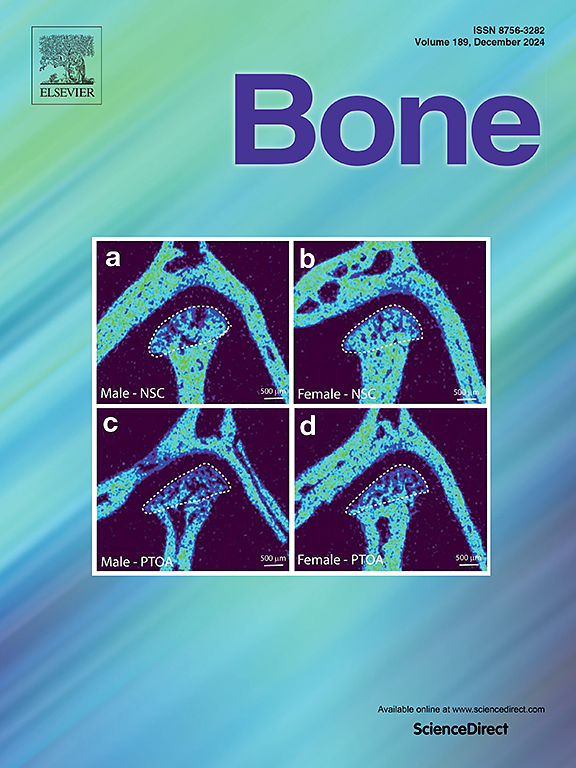Extracellular pH is a critical regulator of osteoclast fusion, size and activation
IF 3.5
2区 医学
Q2 ENDOCRINOLOGY & METABOLISM
引用次数: 0
Abstract
Osteoclast activity is regulated by extracellular pH, whereby bone resorption is near-maximally activated at pH 7.0 but limited at ≥pH 7.4. This study examined the effects of low pH on osteoclast fusion, multi-nucleation, resorption and cell transcriptome. Osteoclasts were cultured on dentine discs at pH 7.4 (control) or pH 7.0 (acidified) for 5–7 days. Osteoclast number and resorptive activity were 1.9-fold and 6.7-fold higher, respectively, in acidified cultures. However, acidified osteoclasts were smaller, with fewer nuclei than controls (53 μm diameter with 9 ± 1 nuclei/cell versus 100 μm with 24 ± 3 nuclei/cell). mRNA expression analysis revealed that osteoclast formation and resorption-associated genes were increased in acidified osteoclasts. Switching mature osteoclasts formed for 5 days at pH 7.4 to acidified conditions decreased cell size 30 % within 4 h, resulting in a 2-fold increase in osteoclast numbers after 24 h. Resorptive activity in cells switched to pH 7.0 was visible within 8 h, and by 24 h resorption area was comparable to continually acidified osteoclasts. MicroCT analysis of dentine discs revealed 24-fold and 6.4-fold increases in resorption pit number in pH-switched osteoclasts relative to control and acidified cultures, respectively. RNAseq showed changes in extracellular pH differentially regulated gene expression, particularly metabolic and cell cycle-associated genes. Our results reveal previously unknown effects of extracellular pH on osteoclasts. Specifically, they show pH is an important modulator of osteoclast fusion and size that regulates the transcriptome. Furthermore, small changes in pH can induce significant morphological changes in osteoclasts and act as on/off switch between formation and resorption in ≤4 h.

细胞外pH值是破骨细胞融合、大小和活化的关键调节因子。
破骨细胞活性受细胞外pH调节,其中骨吸收在pH值 7.0时几乎达到最大值,但在≥pH值 7.4时受到限制。本研究考察了低pH对破骨细胞融合、多核、再吸收和细胞转录组的影响。破骨细胞在pH 7.4(对照)或pH 7.0(酸化)的牙本质盘上培养5-7 天。在酸化培养中,破骨细胞数量和再吸收活性分别高出1.9倍和6.7倍。然而,酸化后的破骨细胞体积较小,细胞核数量少于对照组(53 μm直径,9个 ± 1个细胞核/细胞;100 μm直径,24个 ± 3个细胞核/细胞)。mRNA表达分析显示,酸化后的破骨细胞中破骨细胞形成和骨吸收相关基因增加。将在pH 7.4下形成5 天的成熟破骨细胞转换为酸化条件,在4 h内使细胞大小减少30 %,导致24 h后破骨细胞数量增加2倍。切换到pH 7.0的细胞的吸收活性在8 h内可见,到24 h时,吸收面积与持续酸化的破骨细胞相当。牙质盘的显微ct分析显示,相对于对照组和酸化培养物,ph开关破骨细胞的吸收坑数量分别增加了24倍和6.4倍。RNAseq显示细胞外pH差异调节基因表达的变化,特别是代谢和细胞周期相关基因。我们的结果揭示了以前未知的细胞外pH值对破骨细胞的影响。具体来说,他们表明pH值是破骨细胞融合和调节转录组大小的重要调节剂。此外,pH的微小变化可以引起破骨细胞的显著形态变化,并在≤4 h内充当形成和吸收之间的开关。
本文章由计算机程序翻译,如有差异,请以英文原文为准。
求助全文
约1分钟内获得全文
求助全文
来源期刊

Bone
医学-内分泌学与代谢
CiteScore
8.90
自引率
4.90%
发文量
264
审稿时长
30 days
期刊介绍:
BONE is an interdisciplinary forum for the rapid publication of original articles and reviews on basic, translational, and clinical aspects of bone and mineral metabolism. The Journal also encourages submissions related to interactions of bone with other organ systems, including cartilage, endocrine, muscle, fat, neural, vascular, gastrointestinal, hematopoietic, and immune systems. Particular attention is placed on the application of experimental studies to clinical practice.
 求助内容:
求助内容: 应助结果提醒方式:
应助结果提醒方式:


